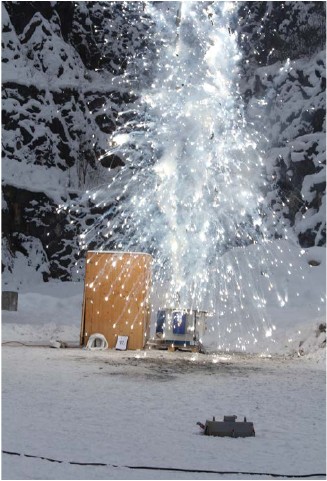Abschnitt 1.4 - 1.4 Molten metals
Molten magnesium burns at the surface in the presence of atmoshperic oxygen.
This is prevented by covering the molten bath surface with protective gas. Depending on the protective gas used, different hazards may result.
The concurrence of molten metal and humidity leads to an increase of the water volume due to the high temperatures. The generated water vapour induces a strong pressure increase and the ejection of the molten metal. As a consequence, the metal ignites at very high temperatures (up to 3000 °C) which causes a "thermolysis" of the water, i. e. a split-up into hydrogen and oxygen. Due to the subsequent oxyhydrogen reaction, an explosion takes place.
During the melting process, a granular slag is formed on the surface of the molten magnesium. It is also called dross and consists of oxidized metal residues. The dross mainly deposits on the molten bath surface, but also in the floor area and at the crucible walls. During the skimming of dross, the magnesium residues adhering to the dross may ignite when coming into contact with air and emit smoke (magnesium oxide).
The dross removed during the skimming of the magnesium baths tends to violent reactions in conjunction with water. If the dross has been quenched with salt after skimming, it is especially important that it does not come into contact with water when cooled down. Otherwise, heating up to self-ignition might occur.
When opening the crucible covers, caking of dross or rust/scale might drop from the crucible wall into the molten metal. This might produce a thermite reaction, leading to possible explosions.

Figure 3
Thermolysis reaction of water (approx. 50 ml) added to molten magnesium
The dross deposits at the crucible walls and in the floor area have an isolating effect. In conjunction with the heating rods on the outside of the crucible, local thermal overheating may occur with the consequence of a crucible rupture.
When pulling temperature sensors, stirring motors, metal pumps, pouring containers etc. out of the molten metal, a high fire risk with smoke generation arises. This is due to the adhering molten magnesium which starts to burn as soon as it comes into contact with atmospheric oxygen.
